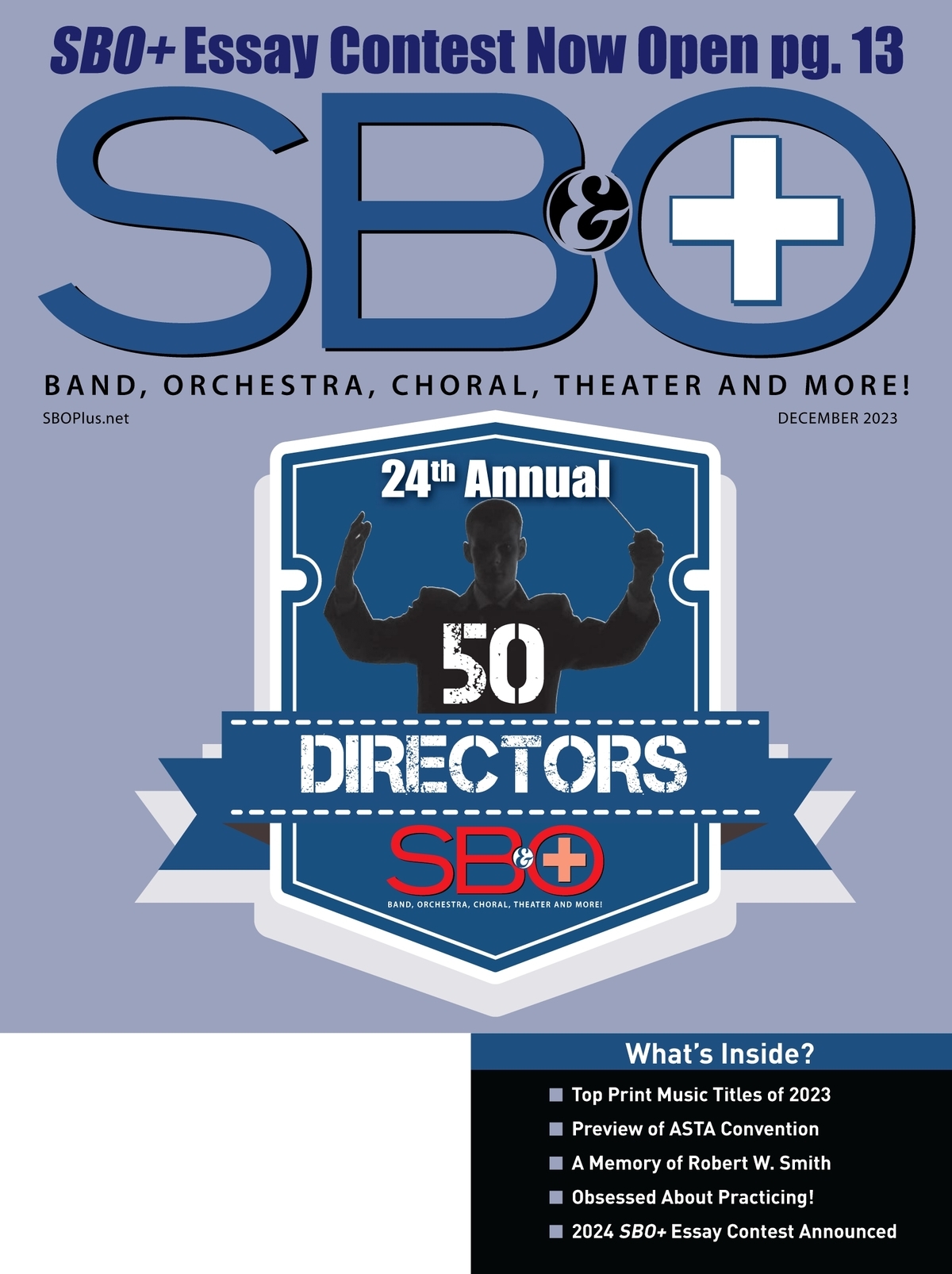EDUCATORS SUBSCRIBE FOR AS LOW AS $0.00! CLICK HERE!
A Drummer’s Thoughts: The sun glints through the band room windows. Spring has finally arrived and what I would give to be outside right now. With this change of season, flowers bloom, grass needs cutting and of course the …man, I wish this stupid fly would go away. The fly lands gently on the pane of glass and I’m poised to strike. I pull back my bass drum mallet like Babe Ruth gearing up to crack another home run. Whack! To my amazement not only did I get the fly, but the mallet shattered right through the window. Cool!
Management & Discipline
Now this exact scenario, described in the lefthand column, played out for my predecessor at Tunkhannock Area High School, but I knew that this type of thing would never happen in my percussion section. I would make sure that the students behaved; after all, it is all about classroom management and discipline. I knew that students would get bored easily and, after all, they are drummers – how much should we really expect? So I started giving my students projects, things that needed to get done. Soon, I was spending more time finding these projects then actually teaching my kids. I finally relented and realized that I, too, was on the same path as that broken window…
A Class of their Own
Two years ago, I finally came to the conclusion that this isn’t working. I had 16 percussion players in marching band, which is wonderful (for some). But then it came time for concert band and I still had 16 percussion players. The majority of my daily rehearsal would be spent looking to see where they had wandered off to, yelling at them to stop playing, or who knows what else they might be doing at the time. And why not: I spent most of the time dealing with the winds and whatever time was leftover, I would spend on the percussion parts. I tried looking for percussion-heavy pieces, but there are only so many and it simply won’t work all the time. So, I decided to take the matters into my own hands and against my better judgment I created their very own class. Seriously, I didn’t know if I wanted to spend an entire class with this bunch. That feeling aside, I tried to think through all the pros and cons. I knew that pulling them out of the daily marching/concert band class would have ramifications. What would we do without the percussion parts there? How would the band react when we added them back in? Could the percussion players learn the parts without the winds being there? Most importantly, I knew that this could turn out to be a disaster, and, if so, then I just won’t do it again. Simple enough, right?
The first hurdle was scheduling. The school never seems to mind when you want to take on more work. I sold it as an offshoot of a weekly sectionals and a way to keep numbers manageable in the marching/concert band section. So, I had all the percussionists register for the new percussion ensemble class and, if their individual schedules allowed, I told them to register for the marching/concert band class. I figured that at with a least a few players we could cover the main percussion parts in the marching/concert band class. I picked up four percussion players in the marching/concert band class and everyone took the percussion ensemble.
And so it began…
Marching Season
During marching season, we were able to work on new cadences, riffs and, yes, even rudiments: Our daily breakdown, in a 40 minute class, began with rudiments, slow until as fast as playable. Next, the body of the class consisted of writing, learning, or cleaning the music, cadences or riffs that we were planning on using for that Friday’s show. This allowed us to continually change music throughout the year and still clean up all the music we learned during band camp. Every week we altered the show, giving the audience a great variety and the percussion a high level of interest and excitement. Fridays would be our cleaning day for that night’s game, which provided a great time for the percussion section to bond with each other. The greatest surprise was how much pride the students garnered from finally being an ensemble and, more importantly, they gained their identity within the band structure. They listened and adapted to the music around them. They were forced to take on more responsibility within the ensemble itself. The marching season was the most successful ever for the percussion section.
Percussion Pieces & Concert Performance
When marching season was over, we started our first ever percussion pieces. I kept it simple and started with body percussion pieces. Body percussion is where different parts of the body are used to make sounds – usually hand claps, finger snaps, foot stomps, et cetera. Some body percussion pieces are actually quite complex and need highly coordinated individuals, so be careful of what you purchase. I started with a piece called Rock Trap by William Schinstine, which has four parts that can easily be doubled or even tripled. Later, we progressed to a more complicated body percussion piece called, Me Tarzan by Chris Crockarell, which uses 8-12 players. This helped us meet some of goals such as reading music, playing together as an ensemble, and they’re fun to do. Yes, I know percussion players, fun, and reading music just don’t seem to go together. It sounds like a cooking show trying to use the wrong ingredients for a recipe, but, it worked.
The next step for us was to introduce something with melodic notation. So we began some simple mallet pieces with two or three parts. I began with Circus, Circus by Chris Crockarell which has a couple mallet parts and tons of auxiliary. We also had fun with a piece called the Big Yellow Mambo by David Steinquest, which is written for 11 players and bass guitar. I happened to have a bass guitar player in percussion ensemble, so that worked out.
Now, at the time we owned only two mallet instruments, a xylophone and a set of orchestra bells. The instruments we didn’t have, we covered with piano or electric bass and this at least covered the part and got the students use to hearing the melodies. The answer to our mallet dilemma was obvious: We needed a marimba, badly. So I went home, wondering how we were going to get a marimba. There was no money to be had through the school, the band boosters didn’t have enough in their account (we had just gone to Disney World the previous week). Then it hit me: why not sell each of the bars on the marimba? People could donate money for the specific purchase of an instrument and we would put their names on plaque and attach it to the instrument. Three things became absolutely certain as we started gathering sponsors: one, most people have no clue what a marimba is; two, they like donating towards a specific item even if they don’t know what it is; and three, they liked having their name on a plaque. We raised enough money in a month and purchased the marimba. We received it about four days before our concert. We plan on expanding our sponsorship program next year and take on an item specific to each of our ensembles.
Once we got a serious foothold in the percussion ensemble music, I started focusing on some of the harder percussion oriented concert pieces. First, we learned the parts without hearing the wind instrument parts. Then as the students became more accomplished, we started playing along with the recordings of the songs. Most recordings are available through individual publishers, music distributors such as J. W. Pepper, or through other ensembles that had performed the pieces and placed the recordings on the Internet. This gave the kids an idea of what all the parts sounded like, what was expected of each performer, and the tempo of the pieces. Of course, this does not make up for live run-through, so as we neared concert time, I scheduled after school rehearsals for the concert band which allowed us to incorporate the percussion back into the ensemble.
What I found is that because of the separate rehearsals, it was just a matter of putting everything together logistically. You must strive to keep the ensemble focused since they need to function both as a part of the concert band, as well as their own ensemble. The concert itself was an alternation between concert band works and the percussion ensemble. The largest challenge was how to move the minimal number of instruments and still be able to have what we needed for each of the pieces. I solved this by placing the percussion on tiers. This gave the audience a clear view of the percussion section and the tiers let the sound carry out without being muffled by the concert band members. The percussion pieces went exceptionally well and at the end of the concert, we received a standing ovation. Ironically, I was happiest that the percussionists were reading music.
Online Resources & Closing Thoughts
The final results were better, and the overall process much easier, than I had expected. Our percussion section has gained a great sense of pride, ownership, and responsibility. The biggest challenge was for me to become well-versed in percussion techniques and lingo. In addition to invaluable assistance from some of my colleagues, I found some Web sites to be extremely helpful.
The first site I used has a huge variety of educational links covering everything from how to properly play rudiments to the bass drum: www.vicfirth.com. Vic Firth’s site is free to use and has resources for both students and teachers. The next Web site I used was specifically for timpani techniques and maintenance: www.ludwig-drums.com/content/education.php. For recordings of ensemble music, as well as the sale of music, I turn to www.jwpepper.com. Recordings are also available through the individual publishers such as www.halleonard. com. There are huge numbers of internet resources available – just search for the specific technique or item you are looking for and then make your students aware that the resource exists. Also, contact those individuals who you have questions for; the majority of time people are willing to share their knowledge.
Above all else, don’t be afraid to try something different. If something isn’t working in the first pace, what difference does it make if it doesn’t work after you make a change? Anytime I start feeling any sense of apathy, I change what I am doing. It helps keep you fresh as the director and, more importantly, it invigorates and reenergizes the program.
Ryan Zellner is the director if instrumental activities at Tunkhannock (Penn.) Area High School, where he has taught since 1998. He holds a Bachelor of Music degree from Moravian College and a Masters degree from the University of Connecticut. Zellner is currently pursuing two Masters degrees – Classroom Technology and Educational Leadership & Strategies – at Wilkes University






